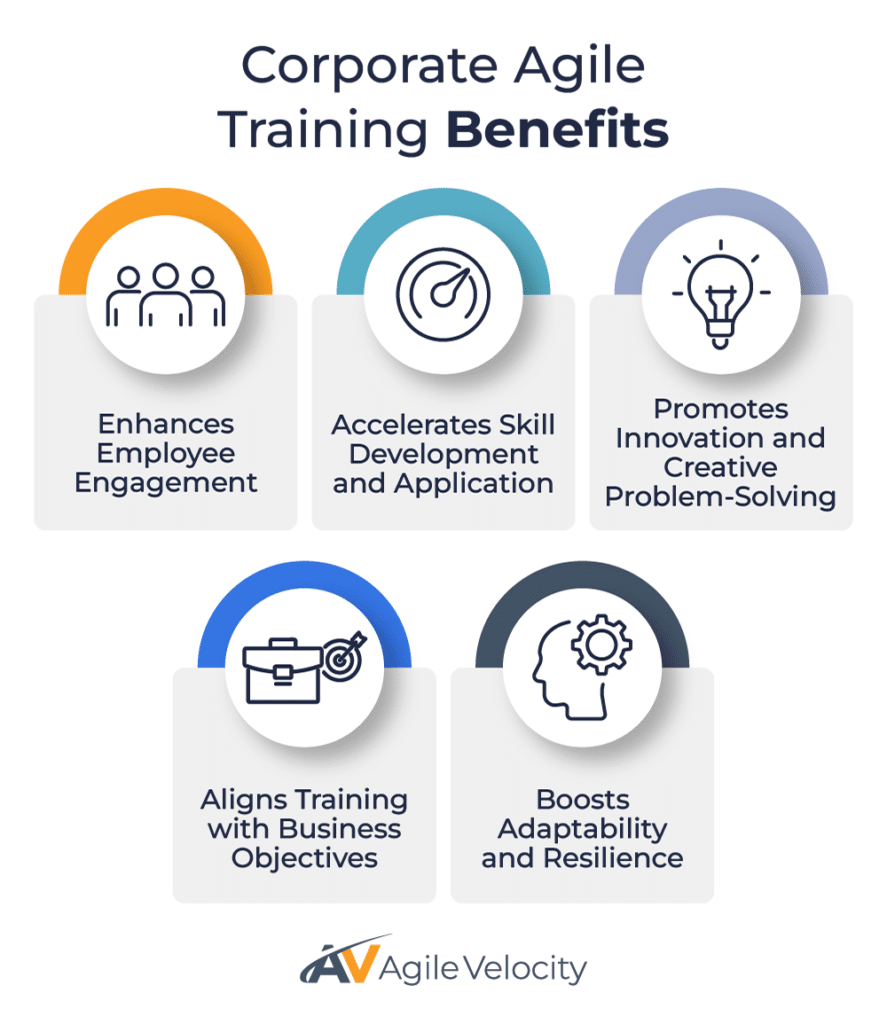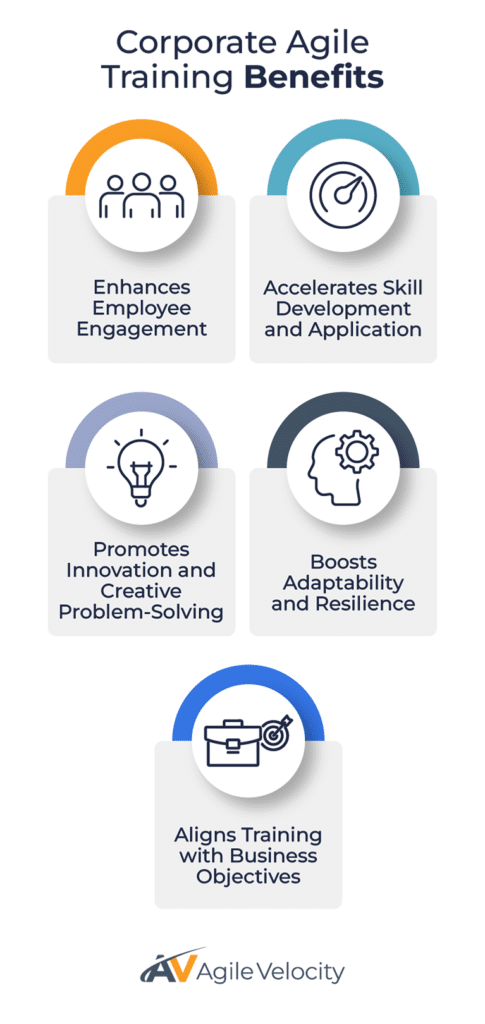Agile learning is transforming corporate training. By emphasizing flexibility, collaboration, and real-time feedback, Agile offers a flexible approach that can enable teams to swiftly adapt to market demands and evolving business goals, particularly in dynamic and rapidly changing environments. For technology managers, corporate trainers, and organizational leaders, embracing Agile learning provides an opportunity to boost efficiency, foster alignment, and drive long-term growth.
This article explores the essence of Agile, its importance in modern organizations, steps for implementation, and strategies for integrating it into existing training frameworks. Additionally, it highlights how Agile Velocity can support your journey toward creating impactful and measurable Agile training programs tailored to your organization’s needs.
What Is Agile Learning in Corporate Training?
Agile is a modern approach that prioritizes adaptability, collaboration, and continuous improvement. Inspired by Agile Methodology, Agile learning applies these principles to corporate training, ensuring programs evolve with organizational needs and challenges.
Traditional training methods often follow rigid, one-size-fits-all models with static content and limited evolution. In contrast, Agile treats training as an ongoing process that adjusts dynamically based on feedback and changing priorities. This iterative approach keeps training relevant, impactful, and aligned with business objectives.
Key traits of Agile include:
- Adaptability: Content evolves to keep pace with new technologies and skill requirements.
- Real-Time Feedback: Continuous feedback loops drive immediate improvements.
- Learner-Centric Design: Participants shape their learning paths, enhancing engagement.
- Alignment with Goals: Training supports organizational objectives by addressing real-world challenges and focusing on outcomes and new capabilities.
Agile learning transforms corporate training into a continuous, strategic enabler of growth, ensuring training efforts stay ahead of business demands and support broader goals.
Why Agile Learning Matters for Modern Organizations

In today’s rapidly evolving business environment, organizations must remain agile to stay competitive. Traditional training methods, often static and inflexible, struggle to keep up with changing technologies and market demands. Agile learning equips organizations with a dynamic approach that evolves alongside these challenges.
Closing Skill Gaps Faster
Agile enables teams to address skill deficits swiftly through iterative, learner-driven sessions. Training content is tailored and frequently refined, allowing employees to acquire and apply new skills in real time, potentially boosting productivity more effectively than conventional methods in certain contexts.
Aligning Training with Strategic Goals
As organizational priorities shift, Agile learning adapts to ensure training content aligns with current business objectives. This iterative structure allows leaders to modify training outcomes in real time, ensuring that learning efforts consistently support strategic goals.
Enhancing Team Resilience and Adaptability
Agile’s focus on short learning cycles, rapid feedback loops, and iteration fosters a mindset of adaptability. This increased flexibility strengthens an organization’s resilience.
Boosting Employee Engagement and Retention
Agile education involves participants in shaping their learning experience, fostering ownership and accountability. Employees engaged in relevant training are more likely to feel valued and satisfied, enhancing employee engagement and retention, and potentially reducing turnover, depending on the organizational context.
Incorporating Agile into corporate training programs is essential for building a workforce that thrives, positioning organizations for long-term success.
Is Your Organization Truly Ready?
Core Principles of Agile
Successfully embedding Agile learning into corporate training requires embracing its key principles, fostering a culture of adaptability, collaboration, and continuous progress. Training ensures the organization and its people are developing new capabilities in order to stay ahead of the competition.
Embrace Continuous Improvement
Agile Learning treats training as an evolving journey. Continuous improvement allows organizations to reflect, refine, and recalibrate training programs regularly, ensuring content and methods remain relevant and effective through continuous feedback and incremental updates.
Foster Collaboration and Open Communication
Collaboration and open communication are vital. Trainers, participants, and leaders must work together, sharing insights and aligning goals to design impactful learning experiences. Open dialogue ensures training programs address real-world challenges and maintain clarity, alignment, and trust.
Enable Learner-Centric Experiences
Agile learning places learners at the center, empowering them to actively shape their development. Participants identify priorities and contribute feedback, fostering engagement and accountability while delivering tailored learning experiences through instructional design.
Leverage Iterative and Data-Driven Approaches
Agile learning relies on frequent iteration and data-driven methods. Training is organized into manageable cycles with specific objectives, supported by data collected from participant feedback and performance metrics. This approach ensures training remains adaptable, relevant, and measurable.
By applying these principles, organizations transform traditional training into dynamic, high-impact programs aligned with business objectives.
Benefits of Agile Learning in Corporate Training
Agile offers a flexible approach that can drive measurable results and boost employee engagement, enhancing the overall impact of learning initiatives. By prioritizing continuous improvement and alignment with organizational goals, it ensures that training programs remain relevant and effective amid changing market conditions. This approach also fosters a culture of innovation and adaptability, empowering employees to continuously upgrade their skills and contribute more effectively to the company’s success.


- Enhances Employee Engagement: Tailored sessions foster ownership and involvement, cultivating deeper engagement as employees see the relevance of their learning.
- Accelerates Skill Development and Application: Iterative and real-time learning cycles enable employees to acquire and apply new skills quickly, potentially driving productivity more effectively than conventional methods in certain contexts.
- Promotes Innovation and Creative Problem-Solving: Regular feedback loops and experimentation empower employees to think creatively and propose innovative solutions.
- Aligns Training with Business Objectives: Agile ensures training programs are directly tied to organizational goals, maintaining relevance as business priorities evolve.
- Boosts Adaptability and Resilience: Cultivating a mindset of adaptability and continuous improvement prepares employees to thrive in changing conditions.
Agile transforms training into a strategic business enabler, ensuring efforts are impactful and aligned with organizational needs.
Addressing and Conquering Agile Learning Barriers
Identifying and overcoming challenges in implementing Agile is crucial for its success. To conquer common obstacles, organizations should foster a culture open to change, invest in necessary technologies, and engage stakeholders through clear communication and continuous involvement, ensuring alignment and support throughout the transition process.
Resistance to Change
Shifting to Agile may face hesitation from employees and leadership. To overcome this, create early wins with pilot programs that demonstrate immediate value, and provide coaching sessions to familiarize stakeholders with Agile principles.
Integrating Agile Learning into Existing Frameworks
Existing training programs may not naturally align with Agile. Start by identifying specific segments that can adopt Agile practices, redesigning these components for flexibility and collaboration. Align Agile learning strategies with key business objectives to ensure a natural fit.
Resource and Tool Constraints
Agile’s iterative cycles may require dedicated trainers and new technologies. Leverage AI to personalize learning experiences and automate feedback processes. Form cross-functional training teams to share expertise and resources effectively.
Mindset and Accountability Shifts
Agile education requires active participation and accountability. Emphasize the benefits of Agile practices to align mindsets, and foster a culture of collaboration, trust, and openness to support the new approach.
Addressing these challenges with clear communication, gradual adoption, effective resource allocation, and an adaptable culture ensures the successful implementation of Agile.
How to Integrate Agile Learning into Corporate Training Programs
Integrating Agile techniques and practices into corporate training programs can significantly enhance their effectiveness and adaptability. This process involves shifting traditional training methods to a more dynamic, iterative approach that prioritizes continuous improvement, real-time feedback, and a learner-centric experience. By adopting Agile principles, organizations can create training programs that are not only aligned with ongoing business objectives but also capable of pivoting quickly in response to changes in the marketplace.


1. Evaluate Current Training Practices
Review existing training programs to identify strengths, weaknesses, and gaps. Use assessments or surveys to gain insights into current methods and opportunities for agile improvements.
2. Define Objectives and Secure Leadership Buy-In
Articulate the goals of Agile and align them with organizational objectives. Define measurable outcomes and gain leadership support by emphasizing the potential ROI in productivity and strategic alignment.
3. Design Iterative Training Cycles
Shift to iterative learning cycles, dividing programs into smaller segments with specific objectives. Incorporate opportunities for reflection and adjustment to make training adaptable and responsive.
4. Leverage Real-Time Feedback and Insights
Incorporate continuous feedback loops to refine training content dynamically. Use data such as learner satisfaction and performance metrics to improve training effectiveness.
5. Train Facilitators and Participants on Agile Concepts
Provide training on Agile principles to trainers, managers, and learners. Understanding concepts like Sprints and retrospectives ensures everyone embraces the agile mindset needed for success.
6. Measure Success and Adapt Accordingly
Track key performance indicators (KPIs) to assess the impact of Agile learning. Regularly evaluate and adjust programs based on insights to maintain relevance and effectiveness.
To successfully achieve this integration, companies need to focus on fostering a culture of collaboration, leveraging data-driven insights to inform training decisions, and implementing flexible frameworks that can evolve as needed. This transformative shift will empower employees to engage more deeply with training content, apply new skills rapidly, and stay aligned with the ever-evolving goals of the organization.
Role of Technology in Agile Learning
Technology is essential in enhancing Agile instruction by supporting collaboration, personalization, and adaptability. By leveraging digital platforms and tools, organizations can foster an interactive and participatory environment where trainers and learners can collaborate seamlessly. Technology can help facilitate personalized learning pathways, allowing learners to progress at their own pace while accessing a wealth of resources. Advanced data analytics provide real-time insights into learner performance, enabling the refinement of training materials and methodologies continuously. These technology solutions also streamline the feedback process, fostering an iterative cycle of improvement that aligns with Agile principles.
Collaboration Platforms
Modern tools create shared spaces for trainers and learners to communicate and share feedback, fostering teamwork and immediate problem-solving.
AI-Driven Personalization
AI-driven tools tailor training content to individual needs based on skill gaps and performance data, ensuring relevant and engaging learning experiences.
Enhanced Learning Management Systems (LMS)
Advanced LMS platforms support real-time updates, adaptive content delivery, and progress tracking, allowing continuous refinement of training programs.
Real-Time Analytics for Decision-Making
Analytics tools provide insights into learner performance and engagement, enabling data-driven decisions to improve training initiatives.
Tools for Scalability and Flexibility
Cloud-based platforms ensure training is accessible to distributed and remote teams, maintaining quality and collaboration regardless of location.
By integrating these technological advancements, organizations can create a dynamic training ecosystem that not only enhances engagement but also drives measurable skill development and adaptability.
Request a Demo
Future Trends in Agile Learning
As the corporate landscape continues to evolve, Agile learning is poised to integrate several innovative trends that will further its effectiveness. These include the increased use of AI-driven analytics to provide deeper insights into learning patterns and optimize training efficiency. Furthermore, there’s a growing emphasis on immersive technologies, such as virtual and augmented reality, to create more engaging and interactive learning environments. These advancements, alongside a focus on microlearning and just-in-time training solutions, are set to redefine how organizations approach employee development and foster a culture of continuous learning.
Increased Adoption of AI-Driven Training
AI personalizes learning paths based on individual needs, offering automated progress tracking and real-time feedback to optimize training outcomes.
Rise of Hybrid and Remote-Friendly Training Models
Agile adapts to hybrid and remote environments, leveraging virtual tools for accessible and flexible training programs that cater to distributed teams.
Gamification and Immersive Learning Experiences
Gamification integrates elements like rewards and challenges, making training interactive and engaging. Experiential learning techniques, such as simulations and virtual reality, reinforce skills in real-world-like settings.
Leveraging Data for Continuous Improvement
Advanced analytics measure knowledge retention and engagement, enabling organizations to refine training programs continuously based on actionable insights.
Integration of Agile into Broader Organizational Strategies
Agile practices become part of overall business strategies, enhancing workforce planning and performance management for comprehensive organizational growth and innovation.
Embracing these trends ensures Agile remains a cornerstone of modern corporate training, enabling organizations to stay competitive and adaptable in an ever-changing environment.
How Agile Velocity Supports Agile Transformations
Agile Velocity assists organizations in adopting Agile practices alongside their broader agility initiatives, promoting effective and sustainable training transformations.
- Comprehensive Training and Certification Programs – Agile Velocity offers workshops and certification programs tailored to Agile Methodologies, helping employees and leaders apply Agile principles in real-world scenarios.
- Path to Agility® Navigator for Measurable Progress – Path to Agility Navigator is software that provides a clear roadmap for organizations to visualize progress, track outcomes, and identify next steps, ensuring continuous improvement and alignment with goals.
- Outcome-Driven Approach to Learning – Agile Velocity focuses on achieving business results, aligning training initiatives with strategic objectives such as faster delivery, and improved quality, ensuring the impact of Agile extends beyond the training room.
- Collaborative Coaching for Long-Term Success – Agile Velocity’s expert coaches support the integration of Agile principles into the organization’s culture, fostering communication and promoting shared ownership of outcomes.
Partnering with Agile Velocity transforms training into a collaborative, adaptable, and scalable process. From dynamic workshops to expert coaching, Agile Velocity provides the resources and expertise needed for impactful and measurable Agile learning programs.
Unlock Your Organization’s Potential with Corporate Agile Training

Agile training and coaching is transforming traditional corporate training by embedding adaptability, collaboration, and continuous improvement at its core. Unlike traditional approaches, Agile enables organizations to evolve training programs in real time, aligning them with shifting business needs and priorities. For HR leads, technology managers, corporate trainers, and organizational leaders, this approach empowers teams to develop skills faster, engage more effectively, and drive meaningful business outcomes.
By embracing Agile learning, organizations can turn training into a dynamic and strategic enabler of growth and agility. Agile Velocity supports this journey with tailored corporate training, public workshops, expert coaching, and innovative tools like Path to Agility Navigator to ensure sustainable results. Ready to unlock the full potential of your corporate training programs? Connect with the Agile Velocity team today to create training solutions that adapt, engage, and deliver success—both now and in the future.



